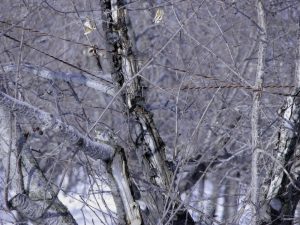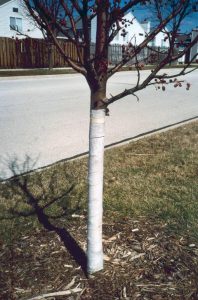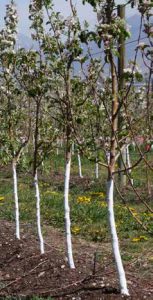Click Here to view the pdf version
JUST THE BASICS: Commercial
GENERAL:
- Mow fallen fruit to reduce pest pressure for next year.
- Mow tall weeds around trees to reduce rodent problems and deer rubbing.
- Make sure all new plantings get white paint (50% latex/50% water) from the base of the tree to scaffold limbs, to prevent sunscald.
- Irrigate this fall before the ground freezes.
APPLE AND PEAR
- To reduce codling moth for next year, remove bins and debris from the orchard after harvest
PEACH/NECTARINE
- Prevent new coryneum blight (shothole infections this fall by applying copper to trees when 50% of the leaves have fallen. Use enough pressure to blow off existing leaves.
Commercial Information
APPLE/PEAR
Pear Psylla
Hosts: pear
Early fall is a good time to treat for pear psylla before the adults migrate to protected areas in leaf litter or on tree bark for the winter.
To determine whether a post-harvest treatment is necessary, examine one shoot on at least 20 trees in your orchard (or 20 shoots on 1 to 2 trees) for the presence of nymphs (usually sitting in a drop of honeydew). If activity is seen on at least 5 shoots, a treatment is warranted. Oil or carbaryl are options.
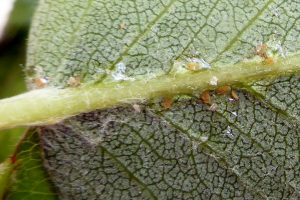
Fire Blight
Hosts: apple, pear
Thankfully, this spring was not a heavy fire blight season. But as fall approaches, it is still important to inspect orchards for fire blight cankers. They are easy to spot because the leaves remain attached to the dead shoots.
The infected shoots should be pruned out when you conduct your normal late winter pruning. At that time (when trees are dormant), it is not necessary to sterilize your pruners between cuts, and affected shoots and branches should be removed 10-12 inches below the visibly diseased tissue. If you are diligent about removing as much fire blight as possible, you are lessening the chances of an outbreak for next season.
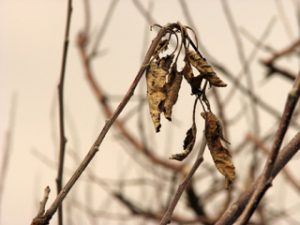
PEACH/NECTARINE/CHERRY
Coryneum Blight
Hosts: peach/nectarine, plum, apricot
The time to treat coryneum blight this fall is when 50% of leaves have dropped. Use a high-pressure sprayer to knock the rest of the leaves off the tree. Options include:
- fixed coppers or copper sulfate (Kocide, C-O-C-S, etc.)
- chlorothalonil or Ziram
When leaves drop, they leave a small open scar, and if any spores land on those scars under the right weather conditions, the fungus will invade the tissue and kill the bud. It is these infections that then lead to new leaf and fruit infections the following spring.
If any orchards have severe infections, it will take at least three years of diligent fall, spring, and summer treatments to suppress the disease incidence.
Bacterial Canker (Pseudomonas syringae)
Hosts: sweet cherry; rarely on peach
Like coryneum blight, new bacterial canker infections can enter trees through leaf scars in the fall. Research out of Oregon State University has shown that an application of fixed copper or Bordeaux Mixture in mid to late October can help reduce the incidence of this disease the following spring.
Bacterial canker is a disease of young sweet cherry trees, or mature cherries affected by winter injury or other factors that cause wounds. The bacteria invade bark and phloem tissue, causing cankers that can grow to eventually kill large branches or the entire tree.
Sweet cherries that show oozing sap from dead buds and twigs, along with clusters of dead leaves or dead shoots, typically means an infection by bacterial canker.
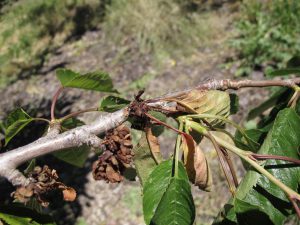
Production Information
FALL ORCHARD CHORES
Keep roots moist: At this time of year, leaves on trees are changing color and dropping, while underground, major root growth is occurring. So it is important to maintain adequate but not excessive soil moisture from now until the soil freezes for winter.
Do not fertilize now: Roots will continue to grow all through fall, but nutrient uptake essentially ceases after the leaves have dropped. It is too late for any fall fertilizer applications, as whatever is applied will leach out of the soil.
Tree removal: Trees suffering from significant insect, disease, or other problems should be removed now. There is still time to install a replacement planting this fall.
Protect from mice, voles: Create or maintain at least 3 feet of clear space from around the base of each tree to help minimize rodents from feeding on bark and roots. Young trees are particularly susceptible to girdling because their trunk circumference is so small. Consider installing a physical barrier around the trunk and down into the soil up to 6 inches.
Prevent winter sunscald: In late winter, bark can be warmed by intense sunlight. If this warming is followed by a cold spell that night, the bark can be killed. Sunscald is one of the primary problems affecting young trees in Utah and is a major factor in the incidence of cytospora canker or flatheaded borers. Protect trunks by applying white tree wrap or painting the trunk and lower scaffold limbs with a 1:1 mixture of white latex paint to water. If using tree wrap, remove it in early April.

